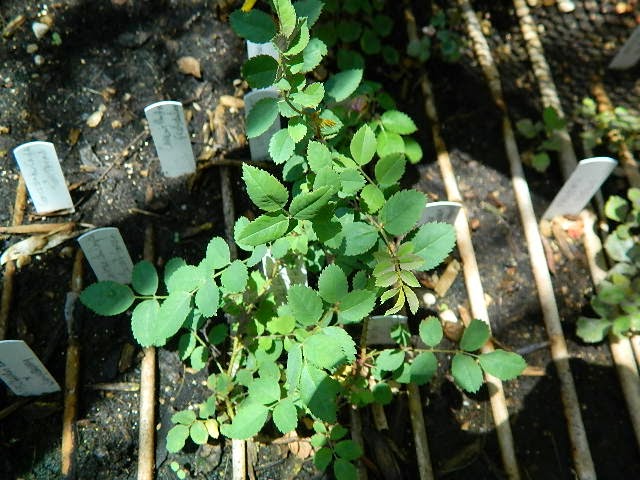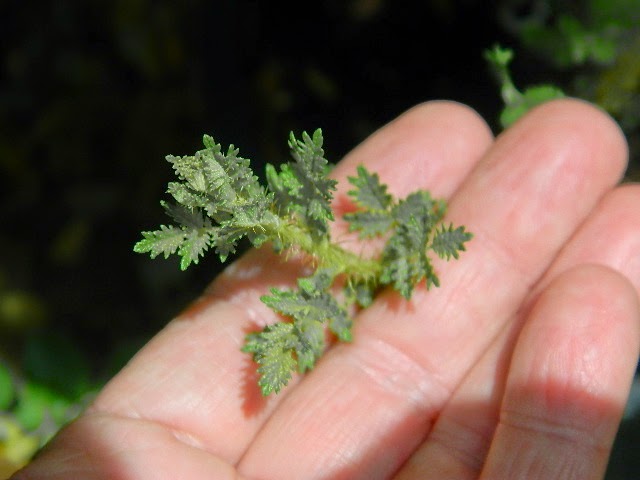Pretty Lady is an extremely healthy plant in my climate. Fortunately, it's also very fertile, both as seed and as pollen parent. The stated parentage includes R. Davidii elongata which has helped give Baby Love, then Pretty Lady their increased black spot resistance, at least to a number of black spot strains. It isn't a cure all for black spot, but definitely the beginning of building improved combinations of black spot resistance.
One of the crosses I made which honestly excited me resulted in these lovely seedlings. Pretty Lady X 1-72-1Hugonis produced this lovely foliage.
I know they are actual crosses between the two parents as the seeds were harvested from Pretty Lady. The color, leaf shape, texture and prickles all point right back to the Hugonis hybrid parent. The foliage is very healthy in a difficult situation of trapped humidity within the seed table. When the sun shines on the box, it is direct, extreme and intense. Even using a moisture control soil, it can dry out quite quickly and the seedlings can fry to death, but these are remaining healthy, vigorous and beautiful. None have flowered yet, so I have no idea what coloring nor flower shapes to expect, but pretty much anything in the white to pastels should be possible.
IHTxLB is a Robert Rippetoe Banksiae hybrid he shared with me several years ago. Robert has some lofty breeding goals and has created some beautiful, incredibly imaginative seedlings. I love the deep purple, single flowers; the healthy, dark, bluish-green foliage and the open habit of the plant. Fortunately, it is very fertile and has accepted a wide range of pollen.
This seedling is also a definite cross between the two parents. The seed parent (mother) combines International Herald Tribune, a rose I imported from the Harkness Nursery back in 1984-85. It figures prominently in almost all the dark purple roses introduced in the past fifteen plus years. International Herald Tribune contains genes from R. Californica, the California native species rose; and several purple, orange and yellow Hybrid Teas and floribundas. The pollen parent for Robert's seedling was Lila Banks, a result of his putting pollen from a friend's creation named "The Monster" on Lilac Charm, a British mauve floribunda introduced in the early sixties from LeGrice, and supposedly also containing R. Californica genes. IHTxLB combines Old Blush, R. Banksiae, R. Californica, a few doses of Grey Pearl, orange, yellow and various mauve modern roses. The pollen I used was from R. Fedtschenkoana, with its wonderful silvery-turquoise foliage and "ghostly" white flowers. You can definitely see the Fedtschenkoana prickles and foliage in this seedling. With any luck, it might even have mauve, to (hopefully!) purple blooms and might even offer some repeat.
The Towhees, a native, "pain in the ear" bird, found digging up the soil in the seed tables irresistible, so I've had to leave the screen cover on this table a bit too long. This and several other overly vigorous seedlings have grown through the screen. I will have to cut openings in it to permit removal without damaging the plants. You can see the definite Fedtschenkoana influence and this one is absolutely vigorous!
Another in the same table, also suffering from having grown up through the screen is a cross between the white sport of Secret called Secret's Out! and R. Fedtschenkoana. Again, the Fedtschenkoana character is obvious. I know this is a definite cross.
Cal Poly can pass on yellow blooms as well as significantly reduced totally prickle-free seedlings. This is Cal Poly X 1-72-1Hugonis. When using the more modern rose as seed parent, you may not obtain quite as full a cross due to potentially mismatched chromosome count, and it's more possible to create triploids, three sets of genes rather than even numbered pairs, which might result in reduced fertility, but definitely not always, but it's tremendously easier to determine if the seedling is an actual cross instead of a self seedling. The Hugonis character is obvious in this seedling. From the lineage, I expect the flower to be some shade of yellow.
Normally, I would not have pollinated Cal Poly with 1-72-1Hugonis because it represents a double dose of 1-72-1, which might result in more of a climbing habit. 1-72-1 is a cross of Little Darling, which can be rangy, and Yellow Magic, a semi climbing yellow miniature. Cal Poly is more dwarf and bushy, but has sported to a climbing form, so climbing plants are possible. 1-72-1Hugonis is a tall plant. Hopefully the more dwarf, bushy genes predominate in this seedling, and the introduction of the Hugonis genes helps dilute the doubled Little Darling and Yellow Magic genes. Hugonis is definitely "in there", as evidenced by the foliage shape, texture and color as well as the prickles.
This seedling has been stunted by the screen the previous seedlings have grown through, but it appears to want to be taller. It resulted from Pink Petticoat X R. Fedtschenkoana. Another obvious actual cross as evidenced by the foliage and prickles. No flowers yet, but they could be anything from pinkish-orange tones all the way through white.
Fedtschenkoana has the ability to bleach out flower pigments quite easily, which is why I continue searching for the darker flower on the silvery-turquoise foliage. So far, the best result has been Paul Barden's Fedlav-01, his cross of my Orangeade X Fedtschenkoana seedling with Midnight Blue. My own seedling using DLFED 3, the mossy Dottie Louise X Fedtschenkoana seedling with pollen from Blue for You, resulted in a plant with lovely silvery-turquoise foliage, but none of the violet tones hoped for. Midnight Blue did appear to help remove the "mossing" from the buds as they are completely smooth.
It appears to be fertile as it has set large, red-orange hips. Whether there are many or few seeds, or even if any seeds present will germinate, we shall see next year.
Not as easily seen due to the screen lid being stuck on the seed table until I cut holes for the other seedlings to pass through, this seedling between Golden Angel and 1-72-1Hugonis is the one I'm really excited to see mature. Golden Angel has a great ability to pass on the character of the pollen parents used on it. Take a look at Ralph Moore's Golden Angel X R. Californica nana hybrid. My hope is this might produce a more dwarf, hopefully repeat flowering Hugonis hybrid without the drawbacks of the doubled genes the previous Cal Poly X 1-72-1Hugonis seedling may express.
This cross was made with the intention of adding the Fedtschenkoana foliage to the violet bloom. It's difficult to determine how much of a real "hybrid" it is and how much of a self crossing it might be as I've not raised seedlings from Werner von Blon until this batch. This is a relatively recent (1993) polyantha from Germany. There is no stated parentage nor are there any documented offspring. This seedling does demonstrate a different foliage texture, color and petal width, texture and color from the seed parent, but little of what I would have through Fedtschenkoana should have provided. I'll have to watch it to see if the species character becomes more apparent with maturity. So far, I do like the results! I've not detected enough scent to determine if any of the "Linseed Oil" scent from Fedtschenkoana is present.
In a previous entry, I posted about the Pink Petticoat X 1-72-1Hugonis seedling which flowered for the first time this past week. This is its sister seedling. It is definitely a hybrid between the miniature and species hybrid, but it isn't expressing the hybrid vigor of the sibling. I've had to move the plant to the front yard where I can better protect it from the severity of the western, afternoon sun. The growth is still too thin to endure hours of relentless sun. Perhaps with some maturity it will become less susceptible to being fried in weather extremes? We'll see.
I find the blue tones of the foliage and reddish bronze of the new growth and prickles more attractive than those of the larger, huskier sister seedling.
Lynnie X R. Arkansana "Peppermint". This cross was meant to see if Peppermint's stippling might express itself in its seedlings.
The next two Springs are definitely going to be fun!








.JPG)
.JPG)
.JPG)








.JPG)
.JPG)
.JPG)
.JPG)
.JPG)

























